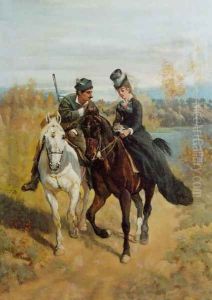Edward Mateusz Romer Paintings
Edward Mateusz Romer was a Polish artist born on January 20, 1873, in the small town of Wadowice, which was then part of the Austro-Hungarian Empire and is now in Poland. He was a versatile artist who worked in a variety of mediums including painting, drawing, and graphic design. His artistic career was marked by a strong interest in national identity and the cultural heritage of his homeland, which was undergoing significant political and social changes during his lifetime.
Romer studied at the Academy of Fine Arts in Kraków, where he was a pupil of famed Polish artists such as Jan Matejko and Leon Wyczółkowski. His education continued in Munich and Paris, which were key European art centers at the time, allowing him to absorb various artistic influences and techniques. Despite his exposure to different styles, Romer remained deeply connected to the artistic traditions of Poland.
Throughout his career, Romer's work was characterized by its emotive intensity and often depicted scenes from Polish history and folklore. He was particularly noted for his portraits and historical paintings, which often reflected his patriotic sentiments. During World War I, he served in the Polish Legions, and his experiences during the war influenced his art, as he created works that depicted the struggles and hopes of the Polish people.
In addition to his painting, Romer was also involved in graphic arts and book illustration. His graphic works often included elements of symbolism and Art Nouveau, and he was recognized for his skill in this area. Romer also took part in the artistic life of Poland, participating in numerous exhibitions and becoming a member of various artistic societies.
After World War II, the changed political climate in Poland affected many artists, and Romer was no exception. Nevertheless, he continued to work until his death on October 19, 1954, in Warsaw. Edward Mateusz Romer's artistic legacy is remembered for its contribution to Polish culture and the preservation of national identity through visual arts.
